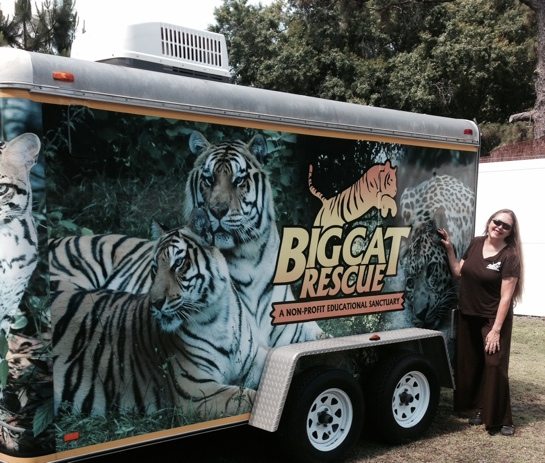Skinny
Why Do Our Cats Look Skinny?
We hear that question a lot and it always surprises us a bit, because we know that our cats live far longer than they do in the wild or even at the best zoos or sanctuaries. We just assume that everyone knows, when they see our cats’ photos and videos, that they are already twice as old as most other cats ever even live to be. Apparently not, so here’s the skinny on why some of our cats look thin.
Whenever we post a photo or video of one of our cats we try to include the name because, if we don’t, the next hundred questions will be, “Who is that?” All of our cats have their own bio page located here: https://bigcatrescue.org/catbio and most are easy to guess, as they will be the cat’s name after the URL, so Keisha would be https://bigcatrescue.org/Keisha If you go to the CatBio page, click on the hyperlinked name of each cat to go to their page, or you can play their story by clicking the play button next to their name.
At the top of each page about the cat, and usually in the recorded story, you will find the cat’s date of birth (DOB). Do the math and you will find that more than 20 of our cats are over the age of 20, which is just about unheard of. Most cats in the wild, or in most captive settings only live to be 10 or 12. When you hear about an exotic cat living to 17 or 20 it’s usually considered newsworthy, and that’s how you even heard about them. Seventeen is our average age of death and as of 2016 we have 60 cats who are over the age of 15. 48 of those are over the age of 18.
Like they say, “Old age ain’t for pussies.”
When animals, including humans, get old we lose muscle mass. Our skin sags, our bones protrude and our gait slows. We lose our teeth and our appetites. In nature the old become prey as they lose their ability to hunt and fend for themselves. In places that force cats to live together, the elderly are often killed by their cage mates and quietly disposed of, before the public shows up… if the public is allowed visitation at all.

At Big Cat Rescue our cats can live alone if they prefer, and most do. That way they never have to fight for food or the right to survive. We base euthanasia on quality of life issues and the advice of our vets. We will assist the cats in having that quality of life with a number of tactics.
- Several meals a day for picky eaters
- After the age of 17 the cats call the shots on whats for dinner and get huge platters of assorted meats to choose from
- We assist with grooming the places they can’t reach
- We provide pain management and joint supplements
- Blood cicles are given daily to those in final stages of kidney failure to keep them hydrated
- Many of the cats have heating pads in their dens, even though it almost never drops to freezing in Tampa, FL
- Sometimes they get misting fans to keep them cool if they seem bothered by the heat
We don’t kill a cat just because it is going to be a huge burden on our finances or our schedule. We wait until the cat tells us that they are done.
That is after we have eliminated all possible reasons for inappetence, such as dental issues, bowel obstructions or infections. When we know that none of those are the reason for the cat giving up their will to live, then we call in the vet to make that transition to the other side as painless and stress free as possible.
Is It Better to Be Fat or Thin?
Ask any doctor and they will tell you that you will live longer if you are lean. Ask any vet if it is better for your pet to be fat or thin and they will tell you that it’s better to err on the side of too thin than too fat. Cats are picky, finicky eaters and what they loved yesterday may bore them to tears today. While we go to the extreme for our elderly or sickly cats, we do mix it up for all of our cats to keep it interesting.
We are the only sanctuary I know that feeds their cats every day. We used to fast on Sundays, but as our population has become so old, we started feeding them every day in 2014. Old or sick cats have always been fed every day. Our primary diet is a ground carnivore diet with all of their vitamins and minerals mixed in, but they get varying amounts of it each day, because let’s face it; who wants meatloaf every day? We also feed varying amounts and cuts of chicken and beef and twice a week they get whole prey (fed dead). They like chicken necks and those are good for cleaning teeth, but are not a primary food source because of the lack of nutrition in that piece of grizzle. Sometimes they get turkey, cornish hens, lamb, and an assortment of organ meats. More about our feeding here: https://bigcatrescue.org/feed-cats/
Despite all of our best efforts, it is a real challenge to keep all 80+ cats at their perfect weight. In the summer, when it’s hot, they just won’t eat, so some get thinner than we would like. In the winter, Mother Nature tells them to bulk up for the freezing famine ahead, but it’s Florida and they are going to get fed every day, so sometimes they get too fat.
What is constant is our attention to their condition. With more than 90 volunteers and interns on the grounds every week, feeding cats and cleaning up what they leave, we get a very good picture of how our cats are doing. After cleaning every day the volunteers and interns log what food was left behind, and what the feces looked like. That sends an email immediately to the CEO, President, Operations Managers and the and anyone else in our volunteer corp who choses to subscribe to those alerts. I can tell you, in real time what a cat did or didn’t eat, what they may have caught on their own, what their poop looked like, and if they were acting weird, limping, etc. because every few seconds I am getting those reports throughout the day. It’s also compiled into each cat’s chart so we can pull up any cat and see everything that has been reported about them. Our vets have access to these records 24/7 via the cloud and their iPhones.
We are constantly discussing individual cat’s diets with our vets and trying to keep them at their healthiest weights. Each of our vets visits twice a week or more as needed. We are also constantly sharing photos and videos of the cats with them, when there is a situation we need them to assess.
Our Cats are Very Very Old
Some of our oldest cats have been Scratch Cougar who was one month shy of 30 when he died and Flavio Tiger who died at the age of 25. At this writing some of our oldest cats are Bongo Serval who is 24, Sabre Leopard who is 23 and The Great Pretender Bobcat who is also 23. To figure out what an exotic cat’s age would be, compared to yours, it is about the same formula as for the domestic cat.
To convert cat age to an equivalent human age, an accepted method is to add 15 years for the first year of life. Then add 10 years for the second year of life. After that, add 4 years for every cat year. This means that by year two, a cat has matured to about the same as a 25 year old human.
That makes Bongo 113, and Sabre and Pretender 109. When you are thinking one of our cats looks thin, please look up their bio, do the math and be as amazed as we are at how good they do look!







